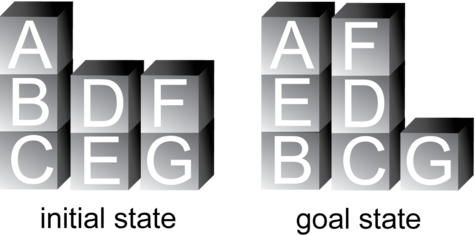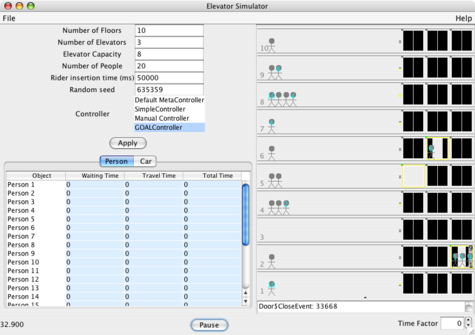GOAL agent program
 |  |
An example blocks world problem | Another Example: A GOAL Multi-Agent Elevator Controller [1] |
|
A GOAL agent program consists of six different sections, including the knowledge, beliefs, goals, action rules, action specifications, and percept rules, respectively. The knowledge, beliefs and goals are represented in a knowledge representation language such as Prolog, Answer set programming, SQL (or Datalog), or the Planning Domain Definition Language, for example. Below, we illustrate the components of a GOAL agent program using Prolog.
The overall structure of a GOAL agent program looks like:
main: <agentname> { <sections> } The GOAL agent code used to illustrate the structure of a GOAL agent is an agent that is able to solve Blocks world problems. The beliefs of the agent represent the current state of the Blocks world whereas the goals of the agent represent the goal state. The knowledge section listed next contains additional conceptual or domain knowledge related to the Blocks world domain.
knowledge{block(a),block(b),block(c),block(d),block(e),block(f),block(g).clear(table).clear(X):-block(X),not(on(Y,X)).tower([X]):-on(X,table).tower([X,Y|T]):-on(X,Y),tower([Y|T]).}Note that all the blocks listed in the knowledge section reappear in the beliefs section again as the position of each block needs to be specified to characterize the complete configuration of blocks.
beliefs{ on(a,b), on(b,c), on(c,table), on(d,e), on(e,table), on(f,g), on(g,table). } All known blocks also are present in the goals section which specifies a goal configuration which reuses all blocks.
goals{ on(a,e), on(b,table), on(c,table), on(d,c), on(e,b), on(f,d), on(g,table). } A GOAL agent may have multiple goals at the same time. These goals may even be conflicting as each of the goals may be realized at different times. For example, an agent might have a goal to watch a movie in the movie theater and to be at home (afterwards).
In GOAL, different notions of goal are distinguished. A primitive goal is a statement that follows from the goal base in conjunction with the concepts defined in the knowledge base. For example, tower([a,e,b]) is a primitive goal and we write goal(tower([a,e,b]) to denote this. Initially, tower([a,e,b]) is also an achievement goal since the agent does not believe that a is on top of e, e is on top of b, and b is on the table. Achievement goals are primitive goals that the agent does not believe to be the case and are denoted by a-goal(tower([a,e,b]). It is also useful to be able to express that a goal has been achieved. goal-a(tower([e,b]) is used to express, for example, that the tower [e,b] has been achieved with block e on top of block b. Both achievement goals as well as the notion of a goal achieved can be defined:
a-goal(formula) ::= goal(formula), not(bel(formula)) goal-a(formula) ::= goal(formula), bel(formula)
There is a significant literature on defining the concept of an achievement goal in the agent literature (see the references).
GOAL is a rule-based programming language. Rules are structured into modules. The main module of a GOAL agent specifies a strategy for selecting actions by means of action rules. The first rule below states that moving block X on top of block Y (or, possibly, the table) is an option if such a move is constructive, i.e. moves the block in position. The second rule states that moving a block X to the table is an option if block X is misplaced.
main module{ program{ if a-goal(tower([X,Y|T])), bel(tower([Y|T])) then move(X,Y). if a-goal(tower([X|T])) then move(X,table). } } Actions, such as the move action used above, are specified using a STRIPS-style specification of preconditions and postconditions. A precondition specifies when the action can be performed (is enabled). A postcondition specifies what the effects of performing the action are.
actionspec{ move(X,Y) { pre{ clear(X), clear(Y), on(X,Z), not(X=Y) } post{ not(on(X,Z)), on(X,Y) } } Finally, the event module consists of rules for processing events such as percepts received from the environment. The rule below specifies that for all percepts received that indicate that block X is on block Y, and X is believed to be on top of Z unequal to Y, the new fact on(X,Y) is to be added to the belief base and the atom on(X,Z) is to be removed.
event module{ program{ forall bel( percept(on(X,Y)), on(X,Z), not(Y=Z) ) do insert(on(X,Y), not(on(X,Z))). } } 

